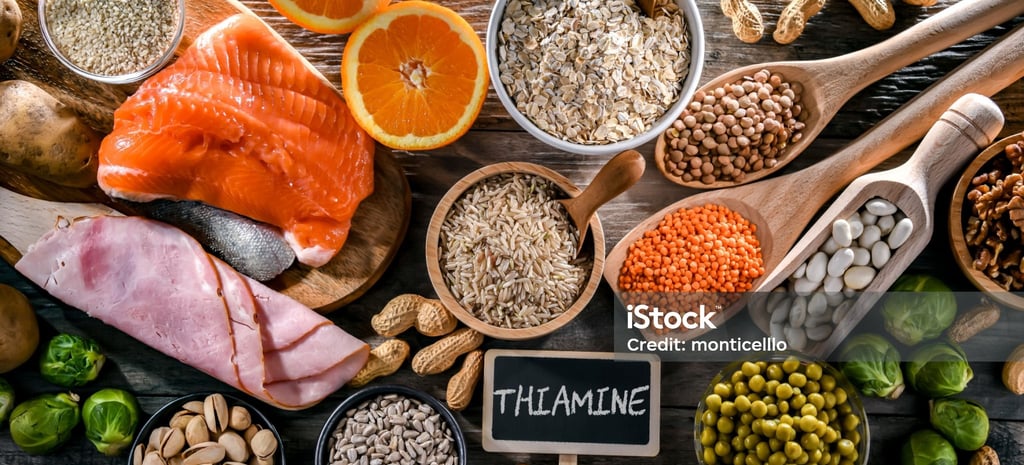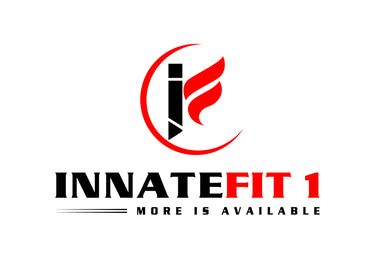Visit Innatefit1.com for exercise wear and equipment!!!
The Thiamine Trigger: Maximizing Muscle Recovery with Vitamin B1 for Faster Gains
Discover how Vitamin B1 (thiamine) fuels muscle recovery, boosts energy metabolism, and accelerates gains. Learn food sources, supplementation tips, and timing strategies to optimize thiamine for enhanced exercise performance and faster post-workout repair.
SELF-HELPWORKOUTSHEALTHY LIFESTYLENUTRITION AND RECOVERYSTRENGTH TRAININGHEALTH
Joseph Battle
5/17/20254 min read


Introduction: The Thiamine Trigger
Understanding why your muscles ache and how they rebuild themselves lies at the heart of every fitness enthusiast’s journey. As you push through sets, sprints, or circuits, microscopic damage occurs in your muscle fibers. Consequently, recovery becomes the foundation for future strength and size gains. Without targeted recovery strategies, progress plateaus, and injury risk climb.
Amid popular recovery methods—foam rolling, protein shakes, sleep hacks—one micronutrient often flies under the radar: Vitamin B1. Also known as thiamine, this water-soluble vitamin plays a pivotal role in turning the food you eat into usable energy, fueling muscle repair and growth. In this post, we’ll explore how Vitamin B1 and exercise performance intertwine, and why optimizing your thiamine status can accelerate muscle recovery on your path to peak performance.
Powerhouse Pathways—Thiamine and Energy Metabolism
First and foremost, Vitamin B1 acts as a coenzyme in key metabolic pathways. Specifically, thiamine pyrophosphate (TPP), the active form of thiamine, catalyzes the decarboxylation of pyruvate to acetyl-CoA. As a result, your cells efficiently enter the Krebs cycle, where they generate ATP—the currency of cellular energy. Without sufficient thiamine, the conversion stalls, leading to reduced energy production and sluggish recovery.
Moreover, studies highlight thiamine and energy metabolism as crucial to sustaining prolonged exercise. Combining an intense workout with low thiamine levels may result in early fatigue and diminished thiamine and physical performance. By contrast, ensuring optimal thiamine intake supports steady ATP turnover, which powers muscle repair processes from the gym until the next training session.
Strength Reinforcer—Thiamine and Muscle Strength
Beyond its role in energy metabolism, Vitamin B1 contributes indirectly to muscle protein synthesis. Efficient energy production ensures that anabolic pathways operate without interruption. Therefore, when you ingest adequate thiamine, you generate fuel and provide your muscles with the resources they need to rebuild stronger. Consequently, thiamine and muscle strength go hand in hand as you progress in your lifting program.
Clinical research underlines this connection. For instance, controlled trials in athletes have shown that thiamine repletion enhances strength endurance, especially during repeated high-intensity sets. These findings suggest that by prioritizing thiamine, you can maintain form under fatigue, lift heavier loads for more reps, and ultimately stimulate greater hypertrophy.
Spotting the Gap—Effects of Vitamin B1 Deficiency on Recovery
Unfortunately, many active individuals overlook thiamine in their diet. When deficiency strikes, hallmark signs include persistent muscle fatigue, cramps, and impaired coordination. These symptoms arise because thiamine shortage slows pyruvate conversion, leading to lactic acid buildup. Consequently, athletes may endure longer recovery times and more pronounced post-workout soreness.
In addition, low thiamine impairs thiamine and lactic acid clearance, prolonging the acidic environment in fatigued muscles. As a result, you might experience that familiar burning sensation long after you’ve finished your workout. Therefore, identifying and correcting deficiencies early can mean the difference between chronic soreness and rapid bounce-back performance.
Everyday Sources—Fueling Gains with Vitamin B1-Rich Foods
Fortunately, you can find Vitamin B1 in many whole foods. Lean pork, fortified cereals, and sunflower seeds top the list, delivering high thiamine content per serving. Moreover, legumes such as black beans and lentils offer plant-based athletes a nutrient-dense alternative. You can naturally boost your thiamine stores by including these options in your meals without relying on pills.
Active individuals typically require around 1.2 mg of thiamine daily, but intense training may push needs closer to 1.5–2 mg. For vegetarians and vegans, who may consume fewer animal sources, anchoring meals around legumes, nuts, and fortified products becomes critical. As a result, you’ll maintain steady Vitamin B1 and exercise performance levels and avoid the performance dips associated with marginal deficiency.
Supplement Savvy—Navigating Thiamine Options for Peak Performance
Even with a balanced diet, supplementation can help you fine-tune your recovery protocol. Thiamine, for example, is available as thiamine hydrochloride or more advanced versions like benfotiamine, which boasts higher bioavailability. Therefore, a well-timed supplement can bridge the gap if you struggle to meet your daily targets through food alone.
When choosing a supplement, look for third-party testing, clear dosage instructions, and formulations that pair thiamine with other B vitamins. Since B-complex vitamins work synergistically, a comprehensive blend can more effectively optimize thiamine and energy metabolism than thiamine alone. Additionally, splitting your dose—half in the morning and half post-workout—may enhance absorption and support sustained muscle repair efforts.
Timing Is Everything—Thiamine Intake for Optimal Results
While total daily intake matters most, timing your thiamine can further amplify recovery. First, consume a B-rich meal or supplement 30–60 minutes before training. This approach ensures that thiamine is available when your muscle cells switch into high-energy mode. Then, follow up with another serving immediately after your workout to aid in thiamine and physical performance restoration.
Furthermore, some athletes adopt a pre-bed snack containing whole grains and nuts, providing a slow-release thiamine source overnight. As sleep orchestrates critical muscle repair, maintaining nutrient availability during rest supports uninterrupted recovery. Consequently, you wake up feeling more energized and ready to tackle your next session.
Beyond B1—Synergistic Recovery Strategies for Unstoppable Progress
Although Vitamin B1 offers powerful recovery benefits, it shines brightest within a holistic regimen. In addition to thiamine, ensure your diet delivers adequate protein, healthy fats, and other micronutrients such as magnesium and zinc. Proper hydration further accelerates nutrient transport and waste removal from fatigued muscles. Meanwhile, active recovery techniques—light cycling or mobility work—help minimize stiffness and improve blood flow.
Equally important, prioritize sleep and rest. Aim for 7–9 hours of quality sleep each night, as growth hormone secretion peaks during deep stages and amplifies muscle repair. Finally, avoid overtraining by scheduling regular deload weeks and listening to your body’s signals. Combined with optimal thiamine status, these strategies create a recovery ecosystem that propels you toward continuous gains.
Conclusion: Energize Your Regimen with Thiamine and Muscle Performance
Vitamin B1 plays an indispensable role in muscle recovery by powering ATP generation, supporting protein synthesis, and aiding lactic acid clearance. Whether you obtain thiamine from whole foods like pork, legumes, and fortified grains or supplement with high-quality benfotiamine, maintaining robust thiamine levels can elevate your exercise performance and fast-track your gains.
Ultimately, thiamine works best as part of a well-rounded strategy that includes balanced nutrition, smart hydration, quality sleep, and strategic rest. Therefore, consult a healthcare professional or registered dietitian to tailor your thiamine intake to your needs. With the right plan, you’ll harness the full potential of thiamine and muscle strength, transforming every workout into measurable progress.




